Dental Implants
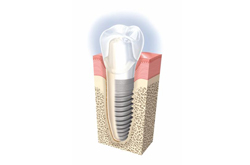
Dental implants are replacement tooth roots. Dental Implants provide a strong foundation for permanent or removable prosthesis (replacement teeth) that are made to match your natural teeth. They are manufactured from biologically neutral pure Titanium that is accepted by the human body and these implants fuse with the jawbone to form a secure foundation for tooth replacement.
It usually takes 3 to 6 months for the implant to fuse to the surrounding bone. Once that has happened, a crown is placed directly on the implant or more often to another piece called an abudment between the crown and the implant. You now have a sturdy tooth replacement that is visibly indistinguishable from a natural tooth.
Dental implants are very versatile and can be used in a variety of ways to replace missing teeth from a single tooth to implant supported bridge work. They can also be used to support and secure complete dentures and total replacement of teeth.
Research has shown a success rate close to 97% making implants the most economic long term tooth replacement solution available. Certain factors like smoking, uncontrolled diabetes, osteoporosis may interfere in implants properly fusing to the bone.
- An implant is a fine rod of metal that is inserted into the jawbone.
- It takes the place of the natural root, which was removed when the tooth was extracted.
- This titanium root or implant can anchor a replacement crown or a bridge that is cemented or screwed to it.
- Titanium is used as it is exceptionally well tolerated by the human body, and is seldom rejected.
- It is also extremely strong and durable.
 Implant
Implant
 Crown on Implant
Crown on Implant
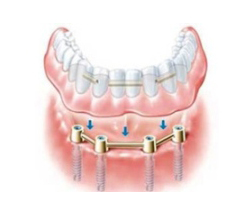 Implant + Bar for Denture
Implant + Bar for Denture
Dental Implant Treatment
- Insertion of the Implant
- Healing of the gum
- Exposure of the Implant site
- Taking the impression
- Insertion of crown and bridge or over-denture
The placement of the implant is followed by a healing period of between 3 and 6 months in which the bone bonds to the implant. At the end of the healing period, a return visit of between 5 and 15 days is required for the fitting of Porcelain or Procera Crowns. Many patients can divide the second stage into two parts, with a 1-2 week break in between.
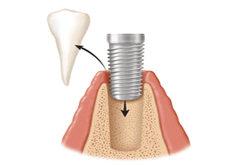
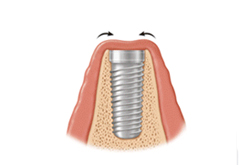
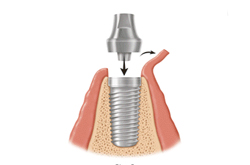
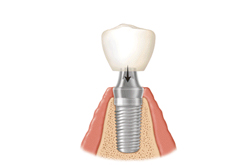
Benefits of Dental Implant
- Implants are the most natural looking and stable replacements for lost teeth.
- No clasps or visible attachments are required.
- No cutting down of adjacent natural teeth is required.Since implants share the functional load during chewing, they contribute to maintaining the health of other teeth.
- Implants are ideal replacements for preserving the health of the remaining bone left after loss of teeth.
- They do not shift or slip like removable partial dentures or complete dentures.
- Nearly the same shade as natural tooth can be acquired.
- Provides a long term solution.
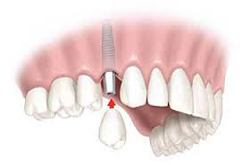
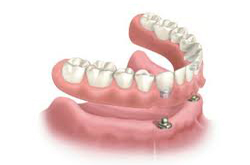
With all these benefits, implants are nearly ideal solutions for problems related to loss of teeth, thereby enhancing your confidence and giving you that smile back.
-
Is dental implantation a successful way of replacing missing teeth?
- An implant is a fine rod of metal that is inserted into the jawbone.
- Dental implantation is a very successful method of replacing single or multiple missing teeth.
- Implants can be used to anchor an individual replacement crown, or a bridge replacing one or more missing teeth.
- Titanium implants can be used to support fixed bridges, even if there are no natural teeth left in the mouth.
- Implants can also be used to support removable partial dentures, making them far more comfortable to wear.
- A few implants can also make a full denture far firmer and more comfortable.
- Implants permit normal and comfortable chewing.
- Crowns and bridges anchored by implants are made to look natural and to match the surrounding teeth.
- They are functional, as well as aesthetic.
-
Is there pain or discomfort?
Many patients report dental implant surgery to be less troublesome than having teeth removed. The dental implants are placed using a simple local anaesthetic, and sometimes with sedation if you are very nervous. Most patients report that they were much more comfortable following the procedure than they had anticipated.
-
Will I be without replacement teeth at any time?
There are several different ways to get temporary teeth during the healing period. Most people just wear their existing denture during this time. Some people have been without teeth for a long time and so are happy to go without temporaries for a few months. For those who are not it is usually possible to get fixed or removable temporary teeth. Fixed temporaries are more expensive as they are dental bridges bonded to the adjacent teeth. Removable teeth such as dentures may be made by a laboratory or you may use your existing dentures during the healing phase.
-
How long does the treatment take?
The placement of the implant requires a visit of 3-5 days and is followed by a healing period of between 3 and 6 months during which time the bone bonds to the implant. You can wear your denture during this healing time. At the end of the healing period, a return visit of between 5 and 15 days is required for the fitting of Porcelain or Procera Crowns or over-denture. Many patients can divide the second stage into two shorter visits, with a 1-2 week break in between.
